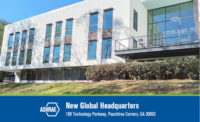ATLANTA — ASHRAE is poised for a busy year in 2019. At its 2019 Winter Conference in Atlanta, the 56,000-member engineering association introduced a lengthy agenda that included renovation of a new net-zero world headquarters, the signing of a memorandum of understanding with the Pakistan HVACR Society (PHVACR), a pledge to prepare building professionals for the challenges and opportunities of designing efficient and grid-responsive buildings within the changing energy sector, and more.
Building a New Energy Future
In the words of 2018-2019 ASHRAE President, Shelia J. Hayter, P.E., the organization is “Building a New Energy Future.”
“We’re at the forefront of a major evolutionary change in how energy systems interact,” said Hayter, who also serves as a research advisor with the integrated applications center at the U.S. Department of Energy’s National Renewable Energy Laboratory in Golden, Colorado. “Instead of individual systems — buildings, utilities, the transportation sector, and the industry sector — it’s becoming one system, and buildings are going to play a central role in that new paradigm. Buildings will be where energy is generated, stored, and commandeered, and we will be optimizing energy flow in a different way.”
Buildings will continue to play important roles in the world’s energy future, especially as the traditional electrical grid continues to evolve toward a smart grid with advances in renewable energy. ASHRAE will continue to inform the professionals who guide and design these structures of the steps necessary to move the world’s energy future forward.
“We’re seeing revolutionary changes in the power sector,” Hayter said. “How that electric energy is being generated is changing. Because of these changes, we’re also seeing changes in how energy’s being distributed, how it’s being used, and how it can be shared in other places. Buildings will continue to play a huge role as distributed generation and renewables continue to grow.”
Distributed energy resources (DERs) are significant drivers of change to the electrical grid. While the traditional grid was designed for centralized generation and one-way flow of electricity, DERs change that, placing generation assets on the distribution component of the grid and forcing bi-directional flow of electricity. DERs are very often, although not always, associated with buildings.
“We’re starting to see buildings as places where electricity flows in and out,” Hayter said. “Now, as building engineers, we’re tasked with managing these energy wells to ensure our buildings are comfortable, productive, growing, and providing the best environments for occupants. We’re going to have to expand our knowledge to understand how these energy systems work. This is an exciting time for the building sector.”
Net-zero Headquarters
ASHRAE also announced its intention to dedicate $15.7 million toward the renovation of its new world headquarters building in metro Atlanta. The facility, a 1970s-era building, will be retrofitted into a modern, high-performing, net-zero energy building.
“ASHRAE is excited to demonstrate innovative leadership in our industry by transforming an existing commercial building into a state-of-the-art built environment,” said Hayter. “We want our new world headquarters to be an example of all that we stand for as a society and all that our industry has to offer. This project will serve as an exemplary model for other organizations looking to incorporate similar approaches and designs into new and existing facilities across the globe.”
Rather than construct a new building, ASHRAE opted to renovate an existing building — a decision that was made with the HVAC engineering sector in mind.
“We elected to pursue an existing building because the challenge for most of the facilities in building professionals’ portfolios lies in existing buildings,” said Hayter. “ASHRAE wanted to walk the walk and talk the talk. We wanted to use this opportunity to address some of the challenges that the industry is facing right now and to show it’s possible to take an existing building and turn it into something special.”
ASHRAE is seeking net-zero performance, which may be substantiated through certifications courtesy of LEED, Green Globes, WELL Building, the Living Building Challenge, and others. To fulfill this endeavor, ASHRAE will work to reduce energy consumption to a level below 22 KBtu per square foot per year with a maximum daytime plug load limit of 0.5 W per square foot. ASHRAE intends to move from its current building by October 2020.
2019 Winter Conference
ASHRAE’s Winter Conference, presented in conjunction with the 2019 AHR Expo, welcomed more than 2,700 individuals to Atlanta’s Omni Hotel Atlanta and Georgia World Congress Center.
The event’s technical program featured more than 300 presentations, including a new track that focused on renewable and natural energies, where session topics included exploring energy technologies, renewable energy sources, the future of the smart grid, and more.
“The Winter Conference and AHR Expo provide an excellent setting for building professionals to collaborate on new ideas and share knowledge,” Hayter said. “As we explore ways to incorporate renewable energy technologies into integrated concepts, ASHRAE will take an even greater leadership role in defining the relationship between buildings and the power sector. The Winter Conference and AHR Expo continue to be among the most important platforms through which this knowledge is shared.”
Pakistan HVACR Society
Also during the conference, ASHRAE signed a memorandum of understanding with the PHVACR. The agreement formalizes the organizations’ long-standing commitment toward the promotion of common cooling- and heating-related endeavors.
ASHRAE and UN Environment also announced the launch of its 2019 and 2020 work plan.
“The mutual benefit of the new work plan is that ASHRAE has the ability to make key experts in refrigerant development and the application of new refrigerants accessible to UN Environment through ASHRAE chapters to provide training to national policymakers and practitioners in developing countries,” Hayter said. “As the world shifts toward refrigerants with lower global warming potentials, as mandated by the Montreal Protocol, the linkage between ASHRAE and UN Environment’s Ozone Action unit is critically important to meet global challenges.”
For more information on ASHRAE, visit ashrae.org.






